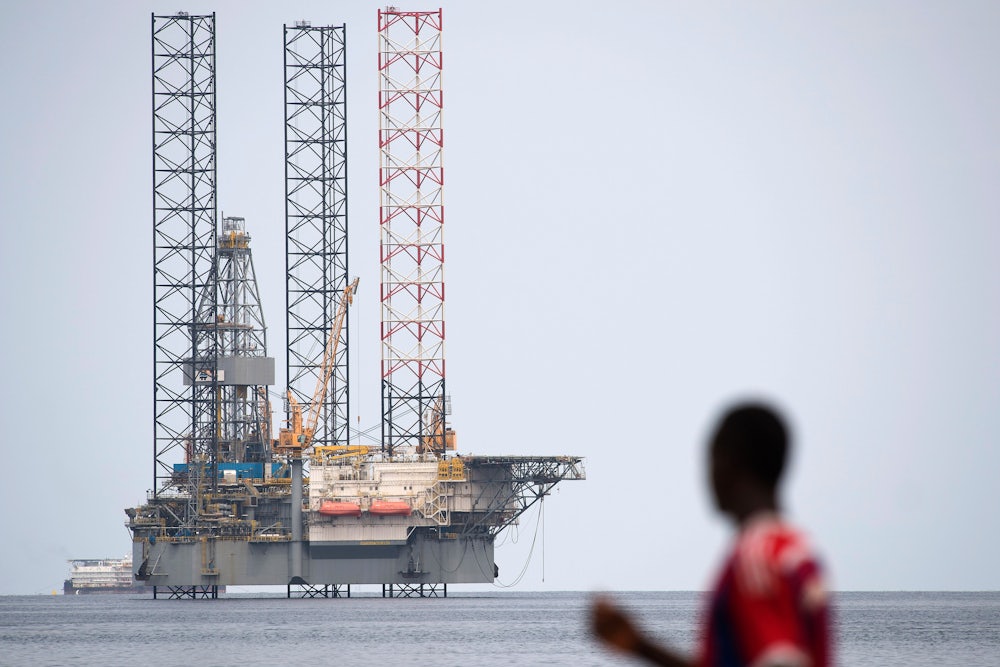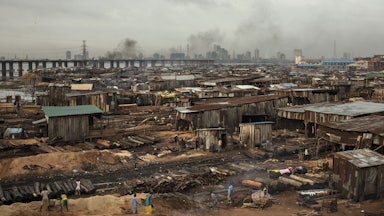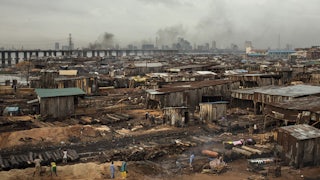Even with governments dangerously behind schedule on emissions reductions, oil producers are beginning to feel the heat. In recent weeks, the United States, China, the European Union, and a handful of international organizations have unveiled plans for alternative energy investments, carbon pricing, and environmental regulations. Their proposals are neither fast enough nor bold enough. But already they have triggered infighting among OPEC nations and a fire sale of oil and gas assets.
In some ways, it’s good news that oil-producing countries and companies are now contemplating a post-oil future. But there’s also cause for concern. Wealthy oil kingdoms may have the time and resources to diversify as oil investors look elsewhere, yet lower-income countries whose economies have been forged around oil by foreign interests and domestic elites will have no such luxury. If the international community hopes to achieve a prosperous clean energy transition, it will have to ensure that these countries do not fall victim to what experts refer to as “traumatic decarbonization”—the destabilizing collapse in government revenues and foreign investment brought on by the global phasing out of oil.
Bigger companies are already adapting to investors’ environmental, social, and corporate governance, or ESG, pressures and preparing for “peak oil,” the point past which global consumption will irreversibly decline. Since 2018, U.S. and European “supermajors” such as BP, Chevron, Eni, Exxon, Shell, and Total have sold $28.1 billion in oil and gas assets, and they are preparing to dump another $30 billion onto the market. Across the industry, $140 billion in oil and gas assets are up for sale as many more companies scramble to free up capital and shift into alternative energy. (It should be noted, of course, that many of these companies are simultaneously funding politicians and policies to forestall serious climate policy and push “peak oil” ever further into the future.)
Wealthier kingdoms in the Organization of Petroleum Exporting Countries, such as Saudi Arabia and the United Arab Emirates, are likewise trying to figure out what to do if stronger environmental regulations overseas, lower alternative energy prices, and changing consumer preferences dry up demand for their oil. Recent estimates suggest that there are fossil fuels worth $900 billion today that will in fact never be extracted and exported and, in the coming years, will be considered worthless.
The issue has provoked an unprecedented debate in OPEC. Should the cartel keep the global supply of oil low to push prices (and profits) higher for as long as the world is buying oil? Or—breaking 61 years of OPEC’s profit-maximization strategy—should it actually pump more oil now, despite the lower prices that would entail, in order to monetize its reserves while it still can?
After an unusually drawn-out fight, in late June and much of July, between Saudi Arabia, which advocated higher prices, and the United Arab Emirates, which advocated higher production and even threatened to leave the cartel during the dispute, OPEC opted for the Emiratis’ proposal. In the two weeks since, prices have moved according to plan, falling from a three-year high of $77 per barrel to $64, before stabilizing in the mid-70s this week.
Wealthy exporters did not blink throughout the saga. They were comforted by the knowledge that their oil production is profitable even at very low prices. They could also take comfort in the performance of other investments: A single bet on Lucid, an electric car company, yielded Saudi Arabia a $20 billion profit this month. But this is a luxury afforded only to the oil kingdoms that boast rich sovereign wealth funds and exceptionally low “fiscal break-even prices,” the price of oil around which oil-exporting countries set their budgets. To balance their budgets next year, the UAE will need a barrel to go for just $60 and Saudi Arabia will require $65, which prices today are comfortably above.
Poorer exporters have little in common with these companies and wealthy countries, lacking both the financial resources to diversify and the low break-even prices to weather oil’s decline. The fiscal break-even price for Nigeria is $133 per barrel, an unattainably high figure, while Algeria and Iran need even more inconceivable prices of $169 and $242 per barrel.
The consequences of low oil prices can be severe for these countries. Recent research from the U.S. Institute of Peace finds that dips in oil prices have repeatedly sparked social unrest for poorer exporters in recent decades.
Covid-19 has offered a preview of this spiral of declining prices, declining government spending, and declining stability. As prices plunged from $70 per barrel to nearly $20 in the first four months of the pandemic—well below Iraq’s $63 break-even price—Iraq’s oil revenues collapsed by 77 percent, leading the country to roll out a brutal set of austerity policies that halted government spending initiatives, delayed public sector salaries, and induced frequent power outages. These exacerbated grievances with the government and fueled a wave of protests, which were met with a violent police crackdown.
As oil fell below Venezuela’s break-even price, the country endured a similar austerity crisis. Unable to turn a profit on the pandemic’s low prices, the government brought oil production to a standstill, setting off fuel shortages, immobilizing domestic transportation, and triggering a nationwide food crisis as uncollected produce wilted away. With similar consequences, Nigeria got ahead of its oil revenue shortfall by cutting health care spending by 40 percent, and Angola did the same by eliminating 25 percent of its government ministries.
The pandemic has shown what poorer oil exporters will face in a post-oil future. Reflecting on
the past year’s difficulties for the Brookings Institution,
Rabah Arezki, the chief economist of the African Development Bank, concluded that “the last oil price super-cycle
might already be underway, the end of which could herald an increase in the
number of failed states.”
It is undoubtedly possible to avoid economic collapse, government austerity, and human suffering as we decarbonize. But it will require considerable planning and funding from the international community, and it will have to go well beyond simply promoting clean energy transitions among lower-income oil exporters. Oil doesn’t just power these countries’ economies, it also funds the vast majority of their government budgets (90 percent in Iraq’s case), provides the vast majority of foreign-currency income (95 percent in Nigeria’s case), and helps cash-strapped governments borrow from foreign creditors by using oil (and oil revenues) as collateral.
Gabon, once a considerable oil exporter, has come upon a novel and sustainable way out of this oil-dependency trap. With 87,000 square miles of rain forest, which absorb 140 million tons of carbon per year, the West African nation has entered the burgeoning business of “carbon credits.” In effect, Gabon preserves its rain forests, calculates the amount of carbon these rain forests absorb, and sells the rights of its carbon absorption to foreign polluters—as many countries and companies are increasingly making carbon-offset pledges. At present, the African Conservation Development Group in Gabon is selling offsets worth $10 per ton (in contracts of 3 million tons per year), but the International Monetary Fund hopes global carbon prices will rise to $75 per ton by 2030—which would constitute a much-deserved windfall for the country.
This is not a perfect solution, given that Gabon’s carbon offsets require others to continue emitting carbon elsewhere. And carbon-offset programs are notoriously fraught with both equity and accounting difficulties: Figuring out a rigorous system for counting carbon offsets, preventing exploitation, and pricing them at increasingly high rates so as to discourage (rather than encourage) future emissions will be tricky. Yet any path to carbon neutrality likely includes large-scale offset programs, and it will be globally beneficial for countries like Gabon not only to escape dirtier paths to economic development but also to gain an enduring source of export revenue and foreign investment.
In recent years, Mozambique and the Democratic Republic of the Congo have similarly begun to monetize their rain forest preservation efforts through $50 million performance-based payments from the World Bank. With considerable natural capacity to absorb carbon dioxide as well, oil producers such as Brazil, Colombia, Ecuador, Equatorial Guinea, the Republic of the Congo, and others can also enter this industry. At some point, they’ll need to transition to getting paid by customers and investors, rather than by donors. Foreign governments and international organizations should help with that, providing the capital needed to get the industry off the ground.
Greater technology transfer will also be necessary to provide low-income countries with alternative energy solutions and compensate for the state-of-the-art resources that oil investments once brought, Arezki has argued. While international organizations so far seem opposed to meaningful amounts of debt forgiveness that could provide a fresh fiscal start for the post-oil challenges ahead, they must at the very least promote greater access to global capital markets and craft smarter debt instruments (like Seychelles’s ocean-preserving “blue bond”) that support sustainable financial development. Increasing wealthy countries’ aid commitments, which have been stagnant at 0.7 percent of gross national income for 50 years, would also help.
It is difficult to identify many rich countries today that did not historically rely on fossil fuels for their development. This presents a haunting uncertainty for poorer countries hoping to trace similar paths to economic success. Coal powered the U.K. through the Industrial Revolution in much the same way that it fueled Japan’s rise after the Meiji Restoration. America’s boom years similarly benefited from the “wildcat” oil drillers that fanned out from Ohio to Texas, and once upon a time China—now the world’s largest oil importer—relied on its oil exports for its own industrial development. No matter how important it is, there is little denying that decarbonization will remove the development ladder that many rich countries have used and many more poor countries intend to follow: cutting off a vital source of export earnings, drying up a trusted pool of foreign investment, and obstructing a reliable route to domestic industrialization.
These are unthinkable developmental headwinds. But as wildfires scorch everywhere from Oregon to Siberia and floods uproot populations from Belgium to China, there is no alternative to global decarbonization. If the world wants to do this—and do it right—poor countries will need its support.








